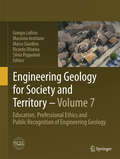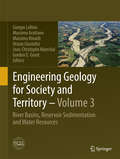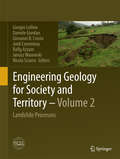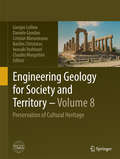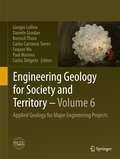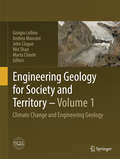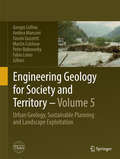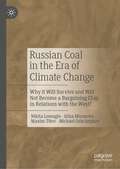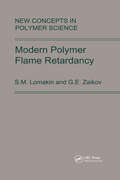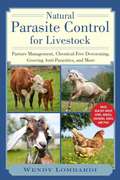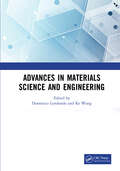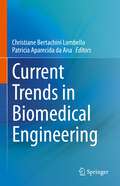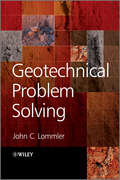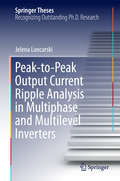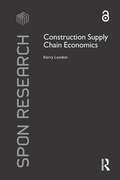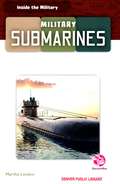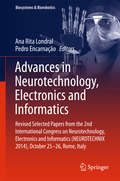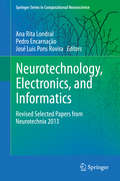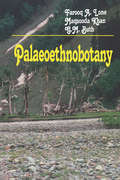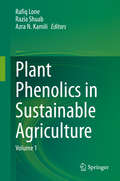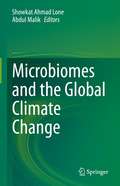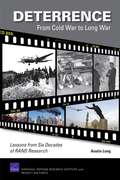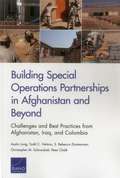- Table View
- List View
Engineering Geology for Society and Territory - Volume 7
by Giorgio Lollino Massimo Arattano Marco Giardino Ricardo Oliveira Silvia PeppoloniThis book is one out of 8 IAEG XII Congress volumes and deals with education and the professional ethics, which scientists, regulators and practitioners of engineering geology inevitably have to face through the purposes, methods, limitations and findings of their works. This volume presents contributions on the professional responsibilities of engineering geologists; the interaction of engineering geologists with other professionals; recognition of the engineering geological profession and its particular contribution to society, culture, and economy and implications for the education of engineering geologists at tertiary level and in further education schemes. Issues treated in this volume are: the position of engineering geology within the geo-engineering profession; professional ethics and communication; resource use and re-use; managing risk in a litigious world; engineering and geological responsibility and engineering geology at tertiary level. The Engineering Geology for Society and Territory volumes of the IAEG XII Congress held in Torino from September 15-19, 2014, analyze the dynamic role of engineering geology in our changing world and build on the four main themes of the congress: Environment, processes, issues and approaches. The congress topics and subject areas of the 8 IAEG XII Congress volumes are: Climate Change and Engineering Geology. Landslide Processes. River Basins, Reservoir Sedimentation and Water Resources. Marine and Coastal Processes. Urban Geology, Sustainable Planning and Landscape Exploitation. Applied Geology for Major Engineering Projects. Education, Professional Ethics and Public Recognition of Engineering Geology. Preservation of Cultural Heritage.
Engineering Geology for Society and Territory - Volume 3
by Giorgio Lollino Massimo Arattano Massimo Rinaldi Orazio Giustolisi Jean-Christophe Marechal Gordon E. GrantThis book is one out of 8 IAEG XII Congress volumes and deals with river basins, which are the focus of many hydraulic engineering and hydrogeological studies worldwide. Such studies examine river systems as both a resource of the fluvial environment, and also explore river-related hazards and risks. The contributions of researchers from different disciplines focus on: surface-groundwater exchanges, stream flow, stream erosion, river morphology and management, sediment transport regimes, debris flows, evaluation of water resources, dam operation and hydropower generation, flood risks and flood control, stream pollution and water quality management. The contributions include case studies for advancing field monitoring techniques, improving modeling and assessment of rivers and studies contributing to better management plans and policies for the river environment and water resources. The Engineering Geology for Society and Territory volumes of the IAEG XII Congress held in Torino from September 15-19, 2014, analyze the dynamic role of engineering geology in our changing world and build on the four main themes of the congress: environment, processes, issues and approaches. The congress topics and subject areas of the 8 IAEG XII Congress volumes are: Climate Change and Engineering Geology. Landslide Processes. River Basins, Reservoir Sedimentation and Water Resources. Marine and Coastal Processes. Urban Geology, Sustainable Planning and Landscape Exploitation. Applied Geology for Major Engineering Projects. Education, Professional Ethics and Public Recognition of Engineering Geology. Preservation of Cultural Heritage.
Engineering Geology for Society and Territory - Volume 2
by Giorgio Lollino Daniele Giordan Giovanni B. Crosta Jordi Corominas Rafig Azzam Janusz Wasowski Nicola SciarraThis book is one out of 8 IAEG XII Congress volumes, and deals with Landslide processes, including: field data and monitoring techniques, prediction and forecasting of landslide occurrence, regional landslide inventories and dating studies, modeling of slope instabilities and secondary hazards (e. g. impulse waves and landslide-induced tsunamis, landslide dam failures and breaching), hazard and risk assessment, earthquake and rainfall induced landslides, instabilities of volcanic edifices, remedial works and mitigation measures, development of innovative stabilization techniques and applicability to specific engineering geological conditions, use of geophysical techniques for landslide characterization and investigation of triggering mechanisms. Focuses is given to innovative techniques, well documented case studies in different environments, critical components of engineering geological and geotechnical investigations, hydrological and hydrogeological investigations, remote sensing and geophysical techniques, modeling of triggering, collapse, run out and landslide reactivation, geotechnical design and construction procedures in landslide zones, interaction of landslides with structures and infrastructures and possibility of domino effects. The Engineering Geology for Society and Territory volumes of the IAEG XII Congress held in Torino from September 15-19, 2014, analyze the dynamic role of engineering geology in our changing world and build on the four main themes of the congress: environment, processes, issues, and approaches. The congress topics and subject areas of the 8 IAEG XII Congress volumes are: Climate Change and Engineering Geology. Landslide Processes. River Basins, Reservoir Sedimentation and Water Resources. Marine and Coastal Processes. Urban Geology, Sustainable Planning and Landscape Exploitation. Applied Geology for Major Engineering Projects. Education, Professional Ethics and Public Recognition of Engineering Geology. Preservation of Cultural Heritage.
Engineering Geology for Society and Territory - Volume 8
by Giorgio Lollino Daniele Giordan Cristian Marunteanu Basiles Christaras Iwasaki Yoshinori Claudio MargottiniThis book is one out of 8 IAEG XII Congress volumes, and deals with the preservation of cultural heritage. In 1972, the World Heritage Convention linked in a single framework the concepts of nature conservation and the preservation of cultural sites. Since then, engineering geology is enlarging its contributions to national and international projects on this topic and is extending its interests to key issues like: safeguarding of monuments and sites from geotechnical perspectives; advanced monitoring; investigations on cultural landscapes; development of geo-databases for cultural heritage classification; studies on the interactions between humankind, natural landscape evolution and cultural heritage; analysis of weathering and deterioration of rock properties of monuments; risk analysis of sites affected by natural hazards and many others. With the contributions in this book, engineering geologists, conservation scientists and further experts from other natural, social and economic sciences, as well as representatives of international organizations and national and local administrative authorities exchange their ideas and practices on culture heritage preservation by presenting both local case studies and multidisciplinary international projects. The Engineering Geology for Society and Territory volumes of the IAEG XII Congress held in Torino from September 15-19, 2014, analyze the dynamic role of engineering geology in our changing world and build on the four main themes of the congress: Environment, processes, issues and approaches. The congress topics and subject areas of the 8 IAEG XII Congress volumes are: Climate Change and Engineering Geology. Landslide Processes. River Basins, Reservoir Sedimentation and Water Resources. Marine and Coastal Processes. Urban Geology, Sustainable Planning and Landscape Exploitation. Applied Geology for Major Engineering Projects. Education, Professional Ethics and Public Recognition of Engineering Geology. Preservation of Cultural Heritage.
Engineering Geology for Society and Territory - Volume 6
by Giorgio Lollino Daniele Giordan Kurosch Thuro Carlos Carranza-Torres Faquan Wu Paul Marinos Carlos DelgadoThis book is one out of 8 IAEG XII Congress volumes, and deals with the theme of applied geology, which is a critical theme for the global economy. In the international, multidisciplinary approach to major engineering projects (either to macro- or mega-scale), the application of geological investigation techniques is fundamental for properly selecting the location sites, planning the construction and maintaining the infrastructures. The contributions in this book include not only engineering constructions but also case studies related to large projects on geo-resources exploration and extraction (minerals, petroleum and groundwater), energy production (hydropower, geothermal, nuclear and others), transportation (railway and highway) and waste disposal as well as the environmental management of these and other activities. The Engineering Geology for Society and Territory volumes of the IAEG XII Congress held in Torino from September 15-19, 2014, analyze the dynamic role of engineering geology in our changing world and build on the four main themes of the congress: Environment, processes, issues, and approaches. The congress topics and subject areas of the 8 IAEG XII Congress volumes are: 1. Climate Change and Engineering Geology 2. Landslide Processes 3. River Basins, Reservoir Sedimentation and Water Resources 4. Marine and Coastal Processes 5. Urban Geology, Sustainable Planning and Landscape Exploitation 6. Applied Geology for Major Engineering Projects 7. Education, Professional Ethics and Public Recognition of Engineering Geology 8. Preservation of Cultural Heritage.
Engineering Geology for Society and Territory - Volume 1
by Giorgio Lollino Andrea Manconi John Clague Wei Shan Marta ChiarleThis book is one out of 8 IAEG XII Congress volumes and deals with climate change affecting different natural processes and environments, such as slope dynamics, water courses, coastal and marine environments, hydrological and littoral processes and permafrost terrain. Due to climate change, major effects are also expected on territorial planning and infrastructure, particularly in extreme climate regions. The volume and its contents aim to analyze the role of engineering geology and the solutions it may offer with respect to the ongoing environmental changes. Contributions regard the modeling of both the factors and the effects induced by climate change. Potential impacts of the climate change on the common practice and routine work of engineering geologists are also analyzed, with particular attention to the risk assessment and mitigation procedures and to the adaptation measures adopted. The Engineering Geology for Society and Territory volumes of the IAEG XII Congress held in Torino from September 15-19, 2014, analyze the dynamic role of engineering geology in our changing world and build on the four main themes of the congress: environment, processes, issues and approaches. The congress topics and subject areas of the 8 IAEG XII Congress volumes are: Climate Change and Engineering Geology. Landslide Processes. River Basins, Reservoir Sedimentation and Water Resources. Marine and Coastal Processes. Urban Geology, Sustainable Planning and Landscape Exploitation. Applied Geology for Major Engineering Projects. Education, Professional Ethics and Public Recognition of Engineering Geology. Preservation of Cultural Heritage.
Engineering Geology for Society and Territory - Volume 5
by Giorgio Lollino Andrea Manconi Fausto Guzzetti Martin Culshaw Peter Bobrowsky Fabio LuinoThis book is one out of 8 IAEG XII Congress volumes, and deals with the theme of urban geology. Along with a rapidly growing world population, the wave of urban growth continues, causing cities to swell and new metropolitan centers to emerge. These global trends also open new ventures for underground city development. Engineering geology plays a major role in facing the increasing issues of the urban environment, such as: finding aggregates for construction works; providing adequate water supply and waste management; solving building problems associated to geological and geomorphological conditions; evaluating host rock conditions for underground constructions; preventing or mitigating geological and seismic hazards. Furthermore, this book illustrates recent advancements in sustainable land use planning, which includes conservation, protection, reclamation and landscape impact of open pit mining and alternative power generation. The Engineering Geology for Society and Territory volumes of the IAEG XII Congress held in Torino from September 15-19, 2014, analyze the dynamic role of engineering geology in our changing world and build on the four main themes of the congress: environment, processes, issues and approaches. The congress topics and subject areas of the 8 IAEG XII Congress volumes are:1. Climate Change and Engineering Geology2. Landslide Processes River Basins3. Reservoir Sedimentation and Water Resources4. Marine and Coastal Processes Urban Geology5. Sustainable Planning and Landscape Exploitation6. Applied Geology for Major Engineering Projects7. Education, Professional Ethics and Public Recognition of Engineering Geology8. Preservation of Cultural Heritage
Russian Coal in the Era of Climate Change: Why it Will Survive and Will Not Become a Bargaining Chip in Relations with the West?
by Nikita Lomagin Irina Mironova Maxim Titov Michael OshchepkovThe Russian coal sector today faces challenges in the form of global decarbonization, sanctions, and difficulties in retaining market access and competitiveness. This new market environment warrants an examination of what lessons can be drawn from the past tribulations of one of Russia’s most iconic and strategically important industries. This book analyzes the Russian coal industry developments in historical and political contexts, including those of energy transition. The key tenets of contemporary dialogue between Russia and those who advocate for a speedy energy transition to phase out coal are presented. The book addresses the question of the coal industry as a sacrifice for the sake of Russia’s rapprochement with the West. The contribution of this book, therefore, is filling the gap between two large research inquiries – climate change mitigation and energy transition on the one hand, and the existing large coal industry of a given country on the other.
Modern Polymer Flame Retardancy
by S.M. Lomakin G.E. ZaikovThere are obvious benefits in using flame-retardants, as many human lives and property are saved from fire. A large number of compounds have been identified as being used as flame-retardants. At present, knowledge of long-term effects resulting from exposure to flame retardants and their breakdown products is limited. The aim of this volume in the book series New Concepts in Polymer Science is to provide a general overview of the nature, mechanism of action, use and environmental hazards for a number of flame-retardants. This monograph (together with the book by the same authors, Ecological Aspects of Polymer Flame Retardancy (1999) will valuable to anyone interested in the field of flame-retardant chemicals.
Natural Parasite Control for Livestock: Pasture Management, Chemical-Free Deworming, Growing Antiparasitics, and More
by Wendy LombardiEverything You Need to Know about Natural Parasite Control for Livestock, All in One Place! This concise book is loaded with valuable information about ridding livestock of their unwanted guests. Whether you're raising sheep, pigs, horses, cows, chickens, goats, or other farm animals, this book will teach you how to keep them healthy and parasite-free through organic systems and without the use of harsh chemicals. It includes easy-to-follow scientific explanations, and provides research-based practices that really work. Internal parasite control can be accomplished naturally 1) through environmental modifications, 2) by producing and using easy-to-grow & harvest anti-parasitics, and, 3) by understanding the life-cycles and road blocks of internal parasites. In this practical guide you will learn about: Parasites, hosts, and lifecyclesHow to develop a working pasture rotation systemHow to create healthy pastures and clean watering systemsAdministering natural antiparasiticsGrowing, collecting, and processing natural and herbal antiparasiticsAnd more! This is a necessary reference manual for all sustainable, natural, animal-husbandry endeavors!
Advances in Materials Science and Engineering: Proceedings of the 7th Annual International Workshop on Materials Science and Engineering, (IWMSE 2021), Changsha, Hunan, China, 21-23 May 2021
by Domenico LombardoThis volume contains the selected papers resulting from the 7th Annual International Workshop on Materials Science and Engineering, and is focusing on the following six aspects: 1. Various Materials Properties, Processing, and Manufactures; 2. Multifunctional Materials Properties, Processing, and Manufactures; 3. Nanomaterials and Biomaterials; 4. Civil Materials and Sustainable Environment; 5. Electrochemical Valuation, Fracture Resistance, and Assessment; 6. Designs Related to Materials Science and Engineering. This proceeding presents and discusses key concepts and analyzes the state-of-the-art of the field. IWMSE 2021 is an academic conference in a series held once per year. The conference not only provides insights on materials science and engineering, but also affords conduit for future research in these fields. It provides opportunities for the delegates to exchange new ideas and application experiences, to establish business or research relations and to find global partners for future collaboration.
Current Trends in Biomedical Engineering
by Christiane Bertachini Lombello Patricia Aparecida da AnaThis book brings together the latest updates from various subareas of biomedical engineering, providing readers with a broad overview of the current state of the art and the technological trends to be refined in the coming years with the goal of improving human health. It shows the important advances in each subfield, rehabilitation technology, computational systems applied to health, and medical devices, with practical examples. It includes topics not covered in other books in the area, such as digital health, bioprinting, organs-on-a-chip, the open data paradigm, and electrical impedance tomography. It is a short and easy-to-read book, and provides bibliographic references for the reader to go deeper into their areas of interest. This book is aimed at a very broad group of professionals and students in biomedical engineering and related areas, seeking to contextualize and understand the latest scientific advances in each subfield of biomedical engineering, including neuroengineering, regenerative medicine, additive manufacturing orthosis, postural analysis of Parkinson's patients, modelling and simulation using biomechanical open data, regenerative medicine, advanced drug delivery systems, bioprinting, biophotonic and electrical impedance tomography.
Geotechnical Problem Solving
by John C. LommlerDevised with a focus on problem solving, Geotechnical Problem Solving bridges the gap between geotechnical and soil mechanics material covered in university Civil Engineering courses and the advanced topics required for practicing Civil, Structural and Geotechnical engineers. By giving newly qualified engineers the information needed to apply their extensive theoretical knowledge, and informing more established practitioners of the latest developments, this book enables readers to consider how to confidently approach problems having thought through the various options available. Where various competing solutions are proposed, the author systematically leads through each option, weighing up the benefits and drawbacks of each, to ensure the reader can approach and solve real-world problems in a similar mannerThe scope of material covered includes a range of geotechnical topics, such as soil classification, soil stresses and strength and soil self-weight settlement. Shallow and deep foundations are analyzed, including special articles on laterally loaded piles, retaining structures including MSE and Tieback walls, slope and trench stability for natural, cut and fill slopes, geotechnical uncertainty, and geotechnical LRFD (Load and Resistance Factor Design).
Peak-to-Peak Output Current Ripple Analysis in Multiphase and Multilevel Inverters
by Jelena LoncarskiThe book introduces an original and effective method for the analysis of peak-to-peak output current ripple amplitude in three-phase two-level inverters. It shows that the method can be extended to both multiphase inverters, with particular emphasis on five-phase and seven-phase inverters, and multilevel ones, with particular emphasis on three-level inverters, and provides, therefore, a comparison among different number of output phases and voltage levels. The work reported on here represents the first detailed analysis of the peak-to-peak output current ripple. It makes an important step toward future developments in the field of high-power generation, and in grid-connected and motor-load systems.
Froggy Builds a Tree House
by Jonathan LondonFroggy and his friends are building a treehouse-with a lot of help from Dad. Their plans don't include Frogilina though. "Boys Only!" says Froggy. But in the end, it's Frogilina who saves the day and joins the treehouse gang. Lovable Froggy returns in his 22nd laugh-out-loud adventure.
Construction Supply Chain Economics (Spon Research)
by Kerry LondonThis is the first comprehensive investigation of the industrial sourcing and procurement practices throughout sixty-eight construction industry supply channels across seven major commodity sectors at all levels. London presents real-world case studies to combine theory and practice to describe the economic structural and behavioural characteristics of sectors integral to the construction industry performance. Construction Supply Chain Economics details 'everyday' experiences and procurement decisions made by people in firms in the industry related to projects as they seek out other firms to work with during the tendering stage. London creates a language that enables us to classify and understand behaviour and recognise the impact of our decisions on firms and projects within the industry. Construction Supply Chain Economics introduces a new model for mapping the construction sector of particular interest to construction management and economic researchers and to procurement decision makers, including policymakers and clients, as well as industry practitioners, such as contractors, consultants and materials suppliers.
Inside the Military Submarines (Inside the Military)
by Martha LondonThis title provides readers with a fascinating look at the mighty military submarines. Vivid photographs and easy-to-read text aid comprehension for readers as they go under water to explore the military's sneaky ships. Features include a table of contents, two infographics, fun facts, a sidebar, Making Connections questions, a glossary, and an index. QR Codes in the book give readers access to book-specific resources to further their learning. Aligned to Common Core Standards and correlated to state standards. DiscoverRoo is an imprint of Pop!, a division of ABDO.
Advances in Neurotechnology, Electronics and Informatics: Revised Selected Papers from the 2nd International Congress on Neurotechnology, Electronics and Informatics (NEUROTECHNIX 2014), October 25-26, Rome, Italy (Biosystems & Biorobotics #12)
by Ana Rita Londral Pedro EncarnaçãoThis book is a timely report on current neurotechnology research. It presents a snapshot of the state of the art in the field, discusses current challenges and identifies new directions. The book includes a selection of extended and revised contributions presented at the 2nd International Congress on Neurotechnology, Electronics and Informatics (NEUROTECHNIX 2014), held October 25-26 in Rome, Italy. The chapters are varied: some report on novel theoretical methods for studying neuronal connectivity or neural system behaviour; others report on advanced technologies developed for similar purposes; while further contributions concern new engineering methods and technological tools supporting medical diagnosis and neurorehabilitation. All in all, this book provides graduate students, researchers and practitioners dealing with different aspects of neurotechnologies with a unified view of the field, thus fostering new ideas and research collaborations among groups from different disciplines.
Neurotechnology, Electronics, and Informatics
by Ana Rita Londral Pedro Encarnação José Luis Pons RoviraThe International Congress on Neurotechnology, Electronics, and Informatics (NEUROTECHNIX) took place in Algarve, Portugal in September of 2013. The congress provided a meeting point of academics and clinical and engineering professionals, promoting translational discussions on how research and technology can meet the needs of clinical practitioners and patients. NEUROTECHNIX emphasized research and application of neurotechnologies to various neurological disorders, including neuromuscular diseases, Parkinson's disease, developmental disorders, dementia, epilepsy, sleep disorders, Multiple Sclerosis, neuroinfections, brain tumors, stroke, traumatic brain injuries, Cerebral Palsy, spinal cord injury and vision and hearing disorders. Authors were invited to submit innovative research work that highlighted new advancements of neurotechnology. Papers describing case studies, advanced prototypes, systems, tools and techniques and general survey papers indicating future directions were encouraged. This book contains a limited selection of extended and revised versions of the best papers presented at the congress, by regular and keynote speakers.
Palaeoethnobotany: Plants and Ancient Man in Kashmir
by F.A. Lone M. Khan G.M. ButhA study of the palaeoethnobotany of Kashmir, covering covers the period from 4500 BP to 1000 BP. It includes keys to the identification of various species of Triticum, Hordeum, Avena and Prunus, and hard and soft woods, and lists the criteria for identification of weed seeds of some 200 species.
Plant Phenolics in Sustainable Agriculture: Volume 1
by Rafiq Lone Razia Shuab Azra N. KamiliThis book presents the latest research on plant phenolics, offering readers a detailed, yet comprehensive account of their role in sustainable agriculture. It covers a diverse range of topics, including extraction processes; the role of plant phenolics in growth and development; plant physiology; post-harvesting technologies; food preservation; environmental, biotic and abiotic stress; as well as nutrition and health. Further the book provides readers with an up-to-date review of this dynamic field and sets the direction for future research. Based on the authors’ extensive experience and written in an engaging style, this highly readable book will appeal to scholars from various disciplines. Bringing together work from leading international researchers, it is also a valuable reference resource for academics, researchers, students and teachers wanting to gain insights into the role of plant phenolics in sustainable agriculture.
Microbiomes and the Global Climate Change
by Showkat Ahmad Lone Abdul MalikThis book covers the contemporary environmental issues faced by life on the planet and the role planetary microbiomes play in such issues. Providing insights on the net favorable and adverse effect of microbial processes, this volume covers both the spontaneous and anthropocentric events that impact climate change and life on the planet. The book describes the ecological significance of microbiomes associated with the kingdoms Plantae and Animalia with respect to climate change, natural and anthropogenic causes of climate change, microbial interactions in nature, planetary microbiomes and food security, climate change in relation to disease epidemiology and human health and engineering microorganisms to mitigate the consequences of climate change. The individual chapters in the intended book provide both theoretical and practical exposure to the current issues and future challenges of climate change in relation to the microbiomes. This collection should serve as ready reference to the researchers working in the area to reshape their future research in addressing the challenges of global climate change.
Deterrence: Lessons from Six Decades of Rand Deterrence Research
by Austin LongSince its inception six decades ago, the RAND Corporation has been one of the key institutional homes for the study of deterrence. This book examines much of this research for lessons relevant to the current and future strategic environment. It is therefore part intellectual history and part policy recommendation, intended to encourage debate and discussion on how deterrence can best be incorporated into U.S. strategy.
Building Special Operations Partnerships in Afghanistan and Beyond: Challenges and Best Practices from Afghanistan, Iraq, and Colombia
by Austin Long Todd C. Helmus S. Rebecca Zimmerman Christopher M. Schnaubelt Peter ChalkBuilding the capacity of Afghan special operations forces (SOF) is a key goal of the United States and its coalition partners. This report summarizes key partnering practices and presents findings from SOF partnership case studies in Afghanistan, Iraq, and Colombia. The goal is to identify best practices to benefit the development of Afghan SOF, as well as for special operations partnerships beyond Afghanistan.
After the War: Nation-building from FDR to George W. Bush
by Austin Long Michele A. Poole James Dobbins Benjamin RunkleFrom the post-World War II era through the Cold War, post-Cold War era, and current war on terrorism, this volume assesses how U.S. presidential decisionmaking style and administrative structure can work in favor of, as well as against, the nation-building goals of the U.S. government and military and those of its coalition partners and allies.
